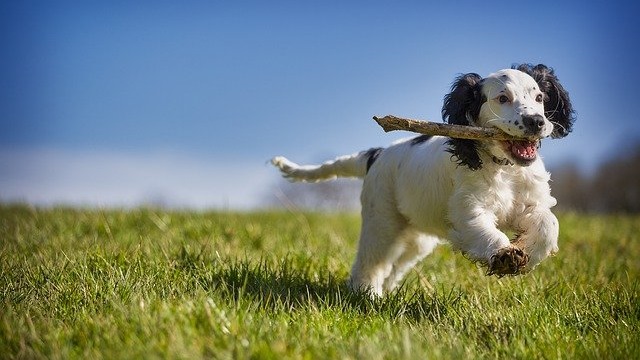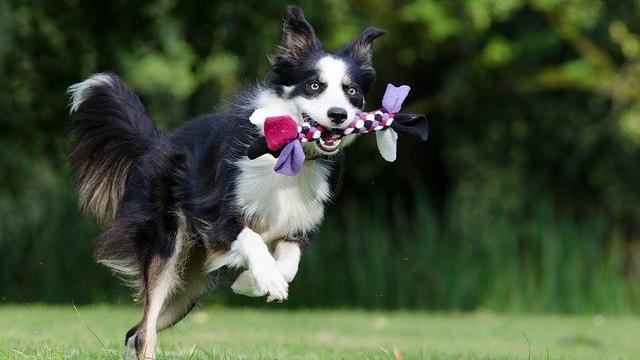Is running around the yard enough exercise for a dog? Perhaps a small walk around the block does the job? Probably not… So the tricky question is, how much exercise does a dog need?
For starters, don’t slack off! Get your buddy in shape and take the opportunity to share some fitness time with them. Not only does it optimize your health, it will also strengthen your bond!
Inactive and sedentary dogs may look cute with their aloofness, but unfortunately their health may be at risk. Obesity is a serious and very common disease that can lead to heart problems, diabetes and joint conditions. Exercising dogs and providing them the proper amount of a high-quality food is thus very important. But how can you tell if they’ve exercised enough? We will give you a hand with that!
How much exercise does a dog need?

Size, age and breed are the main traits to consider when it comes to the amount of activity a dog needs. Another major thing you must not forget is to be realistic and take into account your lifestyle. For instance, if your dog has access to a yard where they can play freely, it is likely they will need less exercising in comparison to a dog who lives in an apartment. Nevertheless, this doesn’t mean that a daily walk is not a requirement for all canines!
A dog is not only made of their breed’s character and genetics. Their individual health is also very important to keep in mind. Check with our vet team or your vet which activities and exercises are more suitable for your dog.
The breed sets a good starting point
Large-sized breeds tend to require longer and more intense exercise sessions, but this is not a golden rule. Let’s dig in and divide breeds in three groups according to their exercise requirements.
Highly active breeds 🐕💨💨💨

➡️ Retrievers, Pointers, Sighthounds like the Greyhound, Samoyeds, Siberian Huskies, Beagles, Boxers, Dalmatians, English Springer Spaniels, and herding dogs like Collies or German Shepherds are some good examples.
➡️ On average, they need at least 120 minutes of active exercise per day. You can divide this time into smaller sessions of 30 minutes. Include periods of more demanding exercise, like jogging or playing fetch, and a relaxed walk within these sessions.
➡️ Remember to adapt the type of activity: Dalmatians or Greyhounds, for example, can reach high speeds quickly, but are unable to maintain it for long. Retrievers, on the other hand, are slower but can have good endurance when properly trained.
Active breeds 🐕💨💨

➡️ Included in this group are for example mountain dogs like Saint Bernards, the majority of Terrier breeds, Basset Hounds, Whippets, mastiff breeds like Bordeaux Mastiffs, Cocker Spaniels, Schnauzers, Poodles, English Bulldogs and Lhasa Apsos.
➡️ This group needs about 60 minutes of active exercise per day. You can also divide this time into smaller sessions. As previously mentioned, periods of intensive exercise with light and short walks in between are preferable.
Less active breeds 🐕💨
(but it doesn’t mean they’re couch potatoes!)

➡️ Bichon Frise, Yorkshire Terrier, Dachshund, Cavalier King Charles Spaniel, Chihuahua, Maltese, Papillion, Pekingese, Pomeranian, Pinscher and French Bulldog, all belong here and they tend to prefer slower and low-intensity activities.
➡️ A 30-minute daily walk is sometimes enough to meet their needs. Including 10 to 15 minutes of a more intense activity within that time is recommended. Tug fighting, letting them run freely in the dog park or playing a small distance fetch are good examples.
➡️ Beware that brachycephalic breeds like the French and English Bulldog have breathing problems due to their short-nosed muzzle. Due to this, their exercise should always be limited and even avoided during the warmest hours of the day. The same should be considered for overweight pets.
The dog’s age has to be considered
Regular exercise will keep your adult dog fit and healthy. As we already explained, their traits set a baseline, but other aspects should be combined, and age is one of them.
Puppies are full of life…

…but too much exercise risks being counterproductive to the growth of bones and joints. Choosing the best activity and getting just the proper amount of exercise might be tricky… Check out the following tips:
- As a general rule, aim for exercising your puppy for five minutes per month of age, twice a day. (e.g. two months = 10 minutes twice a day, four months = 20 minutes twice a day and so on).
- Keep sessions short at first, until your puppy gets used to them.
- Puppies enjoy free playtime. They usually know how to self-regulate and will rest when they are tired.
- Give room for the puppy to take a break and rest.
- While puppies are not fully vaccinated, they will need plenty of short bursts of playing indoors or in a garden/safe area, where they will not get in contact with unvaccinated dogs or their stools.
- It’s a good idea to mix walking on hard surfaces like pavements or roads, with softer surfaces like grass. Otherwise, the paws and limbs might get sore. Dry sand is too soft, though!
- Over-exercising can damage the joints. Avoid endurance and intense exercises – do not take your pup jogging and avoid throwing the ball too far when playing fetch.
- A good mix of walking, playing, training and socializing will keep the puppy both physically and mentally healthy.
Every pup is unique: If they seem like they are struggling, cut down on exercise until their fitness improves. If they still have buckets of energy all the time, then maybe another round of playtime would be wise. The furniture will thank you afterwards!
Regarding healthy senior dogs…

…or the ones whose chronic diseases are well managed:
- Keep exercise regular and gentle. This will keep your old buddy active and help the muscles and joints to age smoothly. Little and often is always the key!
- Never ever stop walking them. They might not be able to go on long walks anymore… But they still need to go outdoors every day to sniff, stretch their legs and get some fresh air.
- Old dogs do not cope well with very high or low temperatures. So, when the weather is unsuitable, provide some exercise sessions inside. Puzzle toys and indoor games are a great way to go!
- All beings gradually lose their five senses with age, and that is why keeping their routines and a predictable environment is so important. Avoid changing the usual walking routes and familiar places. This will prevent anxiousness and confusion in the dog.
- They are the ones who set the pace. Don’t rush or try to make them exercise for longer than they can bear. If they stop chasing a toy or lie down during a walk, it’s because they need to rest.
Conclusion

So, how much exercise does a dog need? Bottom line is, there is no straight answer. Age and the breed’s features, as well as the dog’s individual characteristics, have to be kept in mind when setting an exercise plan. It is expected for doubts to arise and I suggest you seek professional medical advice when they do. Our vet team is available and always happy to help!
Aside from their fragrance, many herbs are brimming with flavor and healing qualities – for our buddies, too! Here are 3 herbs safe for pets. 🌿🐕🐈






